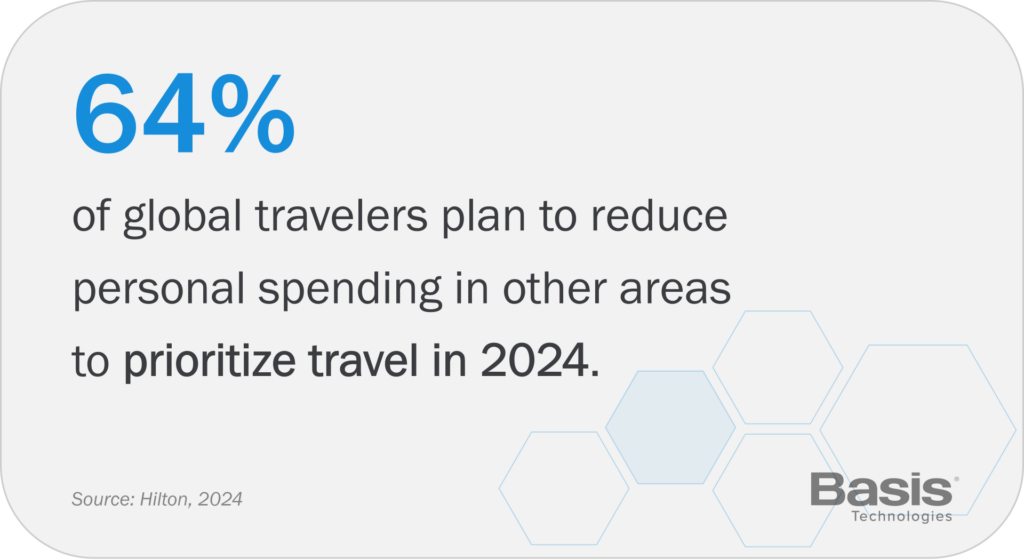
Abrupt stop to nearly all travel during the pandemic? Check. Rapid return to travel in 2022? Check. Economic downturn that throws a wrench into said rapid growth? We’re three for three here, folks. It’s safe to say the last few years have been quite the trip for travel and tourism marketers (see what we did there?)
The good news? Inflation in the US has begun to ease, and even though its effects have lingered, demand for travel has remained robust, fueled by consumers who continue to prioritize experiences and connection over material things. Case in point: 64% of global travelers report that they plan to reduce personal spending in other areas to prioritize travel in 2024. This is especially true for millennials and Gen Z.

So, how can travel and tourism marketers position themselves to make the most of this increased demand for travel in the year ahead? Read on for three key trends to know to stay ahead of the curve in 2024.
Though many consumers report they’re planning to spend more on travel in 2024, they still have lingering price sensitivity from the economic uncertainty of the past several years. As a result, people aren’t necessarily searching with one destination in mind, but may in fact be considering a variety of places to travel and/or experiences—and their decision will likely be based on the value they perceive each option to provide.
For travel and tourism marketers, this combination of increased price sensitivity and willingness to explore multiple travel destinations makes it critical to lean into the value that a specific brand, service, or product can provide. Take, for example, a hotel near a bustling beach town: If that property’s pricing is already competitive with other nearby hotels, they’re going to have to find alternative ways to highlight their value. If they offer certain amenities (i.e., free beach transport, complimentary umbrellas and towels, location within walking distance to popular restaurants), their marketing team should emphasize these benefits through their messaging to show customers the added value they’ll get by choosing their hotel over another that’s comparable in price.
Today’s travelers are multi-faceted and fit into many different buckets—in other words, there’s significant overlap between different traveler “personas.” For instance, someone who used to never mix travel and work might now be a “bleisure” traveler since they work a mostly-remote job but have to travel to on-site meetings several times a year. And that same customer might also be interested in international travel, which they enjoy during their non-busy season.
So, what does this mean for travel marketers? First, it means that most pre-packaged audiences (think: “people interested in traveling to Phoenix”) aren’t cutting it anymore. The solution? Travel marketers can action their brand or property’s first-party data for customization. Going forward, the most successful audience segments will be dynamic and modeled off a destination or property’s owned website traffic. First-party data is more reliable, since it comes from customers themselves, and will allow brands to better craft intentional, personalized advertising experiences to better connect with (and convert) audiences.
It has long been a practice in the travel and tourism industry to show audiences the experience they’ll have with a product, brand, or service, rather than tell them about it. Competition is high between travel brands, and providing an immersive advertising experience to prospective travelers is one way for travel marketers to set their brand apart. Leveraging digital video is a key component of this, especially when long(er) form content (such as CTV) is paired with short-form, less polished content (i.e., user-generated content on social).
And, with new and exciting technological innovations available (such as AR, VR, and AI-generated content), there are even more opportunities for travel marketers to craft compelling creative that motivates audiences to take action. For instance, hotels can leverage AR/VR to offer a “look inside” to prospective guests, ski resorts can utilize these technologies to allow avid skiers to explore their terrain prior to booking, and tour companies can use these tools to preview the experience travelers will have with their company.
With many consumers planning to prioritize travel in the year ahead, marketers in the travel and tourism industries are well-positioned to make the most of this opportunity for growth. By leaning into value-based messaging, leveraging first-party data effectively, and showing exactly what travelers can expect from a certain trip or experience, savvy marketers can grow their brands and forge meaningful—and profitable—connections with key audiences.
__
Hungry for more 2024 trends? Check out our 2024 Trends Report for everything digital marketers need to know for next year.